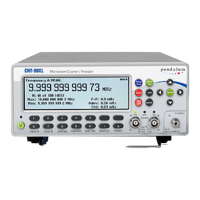When you measure symmetrical signals, such as sine and square/triangle waves, AC coupling filters out all DC
components. This means that a 0 V trigger level is always centered around the middle of the signal where triggering is
most stable.
Fig. 3-4 Missing trigger events due to AC coupling of signal with varying duty cycle.
Signals with changing duty cycle or with a very low or high duty cycle do require DC coupling. Fig. 3-4 shows how
pulses can be missed, while Fig. 3-5shows that triggering does not occur at all because the signal amplitude and the
hysteresis band are not centered.
NOTE: For explanation of the hysteresis band, see page 4-3.
Fig. 3-5 No triggering due to AC coupling of signal with low duty cycle.
4.1.4. Filter
If you cannot obtain a stable reading, the signal-to-noise ratio (often designated S/N or SNR) might be too low, probably
less than 6 to 10 dB. Then you should use a filter. Certain conditions call for special solutions like highpass, bandpass
or notch filters, but usually the unwanted noise signals have higher frequency than the signal you are interested in. In
that case you can utilize the built-in lowpass filters. There are both analog and digital filters, and they can also work
together.
42 / 50

